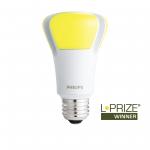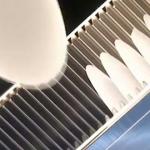I chose to write this post in English as I put a lot of effort into creating this (my first ever) infograhpic and I would like to reach a bigger audience – Hey reddit. 🙂
This Infographic summarizes the current state of LED technology as well as some interesting facts about LEDs. Click the graphic for a full-size view. If you are interested in how I researched all the data or would like to know more about a specific part of the infographic read on and/or leave a comment.
Light output per watt (more is better)
How much energy does an LED convert into light? How do other light sources compare? The numbers are in lumen per Watt, i.e. a higher number reprents are more efficient light source.
- Candle: 0.3 [1]
- 100W Incandescent light bulb: 17.5 [2]
- Fluorescent Tube: 100[3]
- White LED: 150 [4]
- Blackbody Radiator (5800K): 251[5]
Average Lifespan of different light sources
I would like to addd that both incandescent and fluorescent light sources tend to stop working abruptly at the end of their rated life. LEDs however gradually fade in brightness and the time to complete failure can be much longer.
LED TVs – Did you know?
LED TVs are usually regular LCD TVs that are backlit by white LEDs rather than other light sources.[9] However, Sony has recently announced a TV that makes use of tiny single-pixel LEDs with a total resolution of roughly 4 times that of Full-HD (6 million LEDs).[10]
Do LEDs play a role in cars?
15 out of the 15 biggest car makers[11] use LEDs for turn signals, brake lights, daytime running lights or fog lights. 6 out of 15 use pure LED headlights: Toyota, Cadillac (GM), Audi (VW), Ford Racing (Ford), Mercedes Benz (Daimler), BMW.
|
Car maker
|
LED turn signals/brake lights etc.*
|
LED headlights*
|
|
Toyota
|
yes[12]
|
yes[13]
|
|
GM
|
yes[14]
|
yes (Cadillac)[15]
|
|
Volkswagen
|
yes[16]
|
yes (Audi R8)[17]
|
|
Hyundai
|
Yes[18]
|
No
|
|
Ford
|
Yes[19]
|
Yes (Ford Racing)[20]
|
|
Nissan
|
Yes[21]
|
No
|
|
Honda
|
Yes[22]
|
No
|
|
PSA Peugeot/Citreon
|
Yes[23]
|
No
|
|
Suzuki
|
Yes (fog lights)[24]
|
No
|
|
Renault
|
Yes[25]
|
No
|
|
Fiat
|
Yes[26]
|
No
|
|
Daimler (Mercedes-Benz)
|
Yes[27]
|
Yes[28]
|
|
Chrysler
|
Yes[29]
|
No
|
|
BMW
|
Yes[30]
|
Yes[31]
|
|
Mazda
|
Yes[32]
|
No
|
Note: Research for this topic was done in the following way. Google searches were performed limiting the results to the official homepage of one car manufacturer (e.g. site:vw.com) with the addition of led-specific keywords such as “led headlamps” or “led turn signal”, “led taillight”, etc. If none of those phrases appeared on each of the websites the specific manufacturer was classified as not using this technology. If they did, the sites were studied for how they are making use of led technology. This kind of research is not perfect. When a car manufacturer is listed as using the technology, the accuracy is very high as the sources can easily prove this fact. However if the car manufacturer is listed as not using the technology the potential error is rather large as they might be using the technology but it could not be found on the homepage using these Google searches. The actual number of car manufacturers using led technologies can therefore be higher than stated here. If you know about a manufacturer using led technology in a way not specified here, please feel free to contact me.
* = Cars using LED daytime running lights were not considered as using LED headlamps, but rather using LEDs as accessory lights (such as turn lights, brake lights, fog lights, etc.).
Two different ways to produce white light
LEDs come in all different colors, but LEDs emitting white light need to rely on one of two tricks.
R-G-B color mixing
Three LEDs of primary colors emit red, green and blue light. The human eye sees this as white light.
Advantage: Color-Mixing by independent dimming (in a similiar fashion an LCD display or a CRT monitor works)
Application: Entertainment and Architectural ligthing
Phosphor Coating
A blue LED is coated with phosphorus phosphor*. Some of the blue light is directly emitted, some of the light is color-shifted to a different wavelength spectrum. The resultung color mix is perceived as white light by the human eye.[33] This is a similar method as used for fluorescent tubes where UV light is converted into visible light using phosphor. Advantage: Simpler and cheaper then RGB, perfectly suitable for high-power white LEDs.
Application: Replacement for conventional white light sources: incandescent bulbs, street lighting, automotive headlights.
* = Thanks to redditor pork2001 for pointing this error out.
Haitz’s law
According to Haitz’s law the cost to produce 1lm of output is reduced by a factor of 10 within 10 years. During the same time, the lightoutput per LED package increases twenty-fold.[34]
Deutsche Version
Eine deutsche Version ist momentan noch nicht verfügbar, wird aber bald folgen.
[1] Boyd, Robert (1983). Radiometry and the Detection of Optical Radiation. New York: Wiley and Son.





Incredible research!
Well done.
Thanks, man 🙂